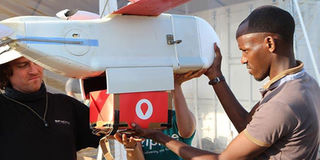Drones set to deliver blood in new project

What you need to know:
The project, funded by the UK’s Department for International Development (DfID), seeks to speedily deliver blood from Dodoma to rural health facilities to prevent women dying through blood loss while giving birth. It is locally coordinated by the Ifakara Health Institute (IHI).
Dar es Salaam. Drones will from next year be used to deliver blood and other medical supplies in a pilot project involving more than 100 health centres in Dodoma Region.
The project, funded by the UK’s Department for International Development (DfID), seeks to speedily deliver blood from Dodoma to rural health facilities to prevent women dying through blood loss while giving birth. It is locally coordinated by the Ifakara Health Institute (IHI).
The programme, whose cost has yet to be revealed, is expected to kick off with ten drones, according to IHI senior research scientist Zacharia Mtema.
Dr Mtema told The Citizen yesterday that the drone would be flying at a maximum altitude of 150 metres, well below altitudes at which manned aircraft fly.
He said blood and other medical consumables would be delivered withing a 75-kilometre radius from Dodoma’s main blood bank.
“There are plans to expand the project to cover the entire country. The project to be launched next year is just the beginning. There will be inter-regional blood delivery drones projects in the long run,” Dr Mtema said.
He added that the project would be a highly coordinated programme involving the ministries of Health, Defence and National Service, Home Affairs and Works, Transport and Communications.
DfID expects each drone to deliver up to 1kg of medical supplies, medicine and blood within 19 minutes of being launched. It currently takes nearly two hours for supplies to be transported by road.
The development follows an announcement by US-based commercial operator Zipline in October that the firm would use drones to deliver blood and other supplies to hospitals across rural western Rwanda as part of an agreement with the Rwandan government.
National Blood Transfusion Services (NBTS) Eastern Zone Manager Eveline Mgasa told The Citizen yesterday that the project aimed to speed up the delivery of life-saving blood to areas where it is urgently needed.
Health ministry statistics show that 80 per cent of the 432 deaths in every 100,000 Tanzanian mothers that occur every year are caused by unavailability blood in emergency situations.
Blood which NBTS collects from donors is still far short of the 450,000 litres needed in the country annually.
According to the BBC, the latest drone interventions aimed at saving lives have been praised by experts, who have cautioned, however, that their use will be limited in the foreseeable future, especially in developing countries.
DfID has also announced plans to fund drone tests in Nepal to map areas of the country prone to damage from extreme weather and make it easier to prepare for future crises, according international news media reports.
Although DfID has not stated how much will be invested in the Tanzanian project, it is estimated that flying blood and other medical supplies by drone from Dodoma to outlying health centres could save at least $58,000 (Sh126.4 million) annually because it is much cheaper and faster than transporting the same by car or motorcycle.
The UK’s International Development Secretary, Ms Priti Patel, was quoted by the BBC saying the new approach would ensure a win-win situation for both the recipient countries and British taxpayers.
“This innovative, modern approach ensures we are achieving the best results for the world’s poorest people and delivering value for money for British taxpayers,” she said.
How the drones operate
The drones, known as Zipline’s drones – also called Zips – are small fixed-wing aircraft that are launched by catapult and follow a pre-programmed path using GPS location data.
The advantage of the design over multi-rotor models is that the vehicles can better cope with windy conditions and stay airborne for longer.
A BBC report quoted experts saying the drones can fly up to 290km before running out of power, although Zipline tries to keep round trips to about half that distance.
Their drawback is that they require open space to land - in Zip’s case an area about the size of two car parking slots.
Zipline gets round this issue by having its drones descend to heights of about five metres when they reach their destinations and then release their loads via paper parachutes. Afterwards, they regain altitude and return to base.




